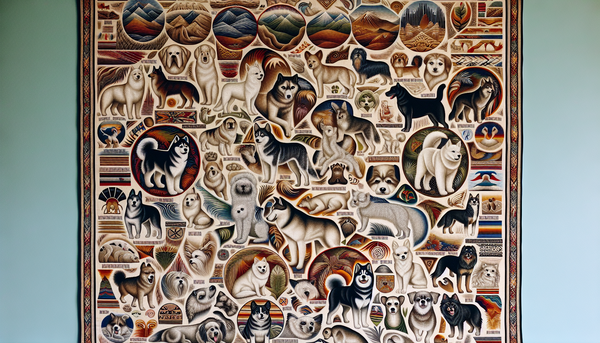The Intriguing Origins of Dog Breeds
If you’re like most dog lovers, you’re not only captivated by the lovable faces and personalities of your four-legged companions but also intrigued by their origins. Dog breeds each have a unique story, one that is often interwoven with the history of human cultures and civilizations. In this deep dive into the fascinating histories of popular dog breeds, we’ll journey back in time to where these canine companions began their relationship with us.
From Wolves to Workers: The Dog’s Evolutionary Tale
Before delving into individual dog breed histories, it’s essential to understand how dogs evolved from wild wolves. Genetic studies suggest that dogs diverged from wolves thousands of years ago, a relationship fostered by mutual benefits in hunting and protection. This collaboration eventually led to the domestication of dogs, forever changing the evolutionary path of man’s best friend.
Labrador Retriever: America’s Beloved Breed
The Labrador Retriever has consistently ranked as one of the most popular dog breeds in the United States. However, its roots trace back to Newfoundland, Canada, where it was initially bred to help local fishermen retrieve nets and fish. Labradors are known for their friendly disposition and hardworking nature, characteristics that have made them not just fantastic pets but also excellent service and rescue dogs. Discover more about their journey from Canadian workers to American household staples here.
The German Shepherd: A Symbol of Versatility
Another breed with an intriguing history is the German Shepherd. Developed in the late 19th century in Germany for herding sheep, their intelligence and trainability quickly made them ideal for various service roles, including police and military work. During World Wars, German Shepherds gained fame for their bravery and versatility. In the post-war era, they became beloved as family pets and Hollywood stars. Learn about their transition from herders to heroes here.
The Bulldog: A Tough Breed’s Transformation
Originally bred in England for bull-baiting, the Bulldog had a reputation for its ferocity and tenacity. However, after the sport was banned in the 19th century, breeders began to emphasize the breed’s more affable traits. Today, Bulldogs are known for their gentle demeanor and have become a symbol of British resilience. They serve as mascots for multiple universities and represent the perfect example of how breeding can transform a dog’s role in society.
French Bulldog: The Aristocratic Companion
The French Bulldog’s ancestors were English Bulldogs, but lace workers from England introduced them to France during the Industrial Revolution. In French society, they became associated with bohemian life and were favored by society’s elite, including famous artists and writers. With their unique appearance and affable nature, French Bulldogs quickly became a fashionable accessory amongst the Parisian upper class.
The Dachshund: A Hunter’s Best Friend
The Dachshund, with its distinctive long body and short legs, was bred in Germany over 300 years ago to hunt badgers and other burrow-dwelling animals. Their shape, stamina, and courage made them exceptional at this task. Over the years, they have transitioned from hunters to beloved family pets, maintaining their energetic spirit and gaining recognition in pop culture with the famous ‘hot dog’ moniker. Find out more about their transformation from the forests to the show ring here.
Golden Retriever: The Scottish Gentry’s Gundog
Bred by Scottish nobility in the 19th century, the Golden Retriever was initially intended for retrieving game in the rugged Scottish terrain. Their soft mouths are perfect for gently carrying hunted game without causing any damage. Today, the Golden Retriever is famed not just for its outdoor abilities but also for its warm character and adaptability to family life.
The Evolution of Dog Breeds and Their Histories
The histories of dog breeds are as varied and intricate as the breeds themselves. As our society evolves, so do the roles and characteristics we select in our dogs. This is reflected in the diverse range of breeds recognized by kennel clubs worldwide. The historical development of breeds is not only a topic of curiosity for dog enthusiasts but also a reflection of our own history as a species. Each breed’s story offers insight into human culture, regional needs, and aesthetic preferences through the ages.
Preserving the Legacy of Dog Breeds
As dog owners and lovers, understanding and preserving the historical legacy of these breeds is crucial. Recognizing the original roles these breeds were developed for helps in appreciating their current behaviors and needs. By exploring the origins of dog breeds, we come to understand and respect these living remnants of our past. We can also ensure that their future remains secure and that their histories continue to be cherished and retold.
Conclusion: A Tail of Time
As we walk down the memory lane of canine history, it’s clear that the journey of each dog breed is a captivating tale tied to the story of human development. These paws from the past have not just shaped the dog world but have also left an indelible imprint on human culture. Barklyz is proud to celebrate the legacy of these remarkable breeds and to share their stories with fellow dog lovers.
- For a deeper understanding of dog evolution, visit National Geographic’s article on the domestic dog.
- Discover how different breeds have been shaped by human needs and aesthetics by exploring the Smithsonian Magazine’s dog facts.
- Support local and national dog organization efforts in breed preservation and canine history education.
May the loyalty and devotion these breeds have displayed throughout history inspire us to be just as steadfast in our care and love for our canine companions.






